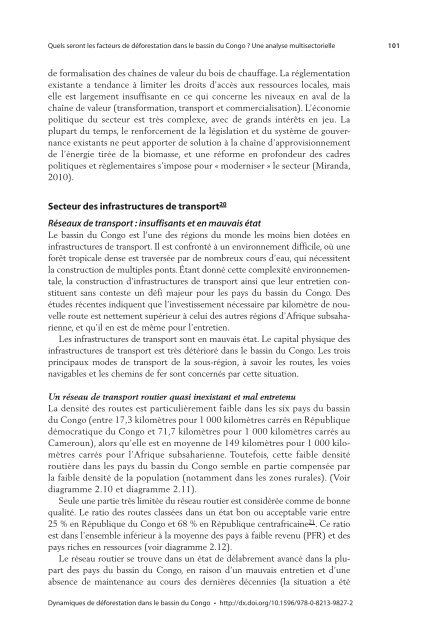Dynamiques de déforestation dans le bassin du Congo
Dynamiques de déforestation dans le bassin du Congo
Dynamiques de déforestation dans le bassin du Congo
Create successful ePaper yourself
Turn your PDF publications into a flip-book with our unique Google optimized e-Paper software.
Quels seront <strong>le</strong>s facteurs <strong>de</strong> <strong>déforestation</strong> <strong>dans</strong> <strong>le</strong> <strong>bassin</strong> <strong>du</strong> <strong>Congo</strong> ? Une analyse multisectoriel<strong>le</strong> 101<br />
<strong>de</strong> formalisation <strong>de</strong>s chaînes <strong>de</strong> va<strong>le</strong>ur <strong>du</strong> bois <strong>de</strong> chauffage. La rég<strong>le</strong>mentation<br />
existante a tendance à limiter <strong>le</strong>s droits d’accès aux ressources loca<strong>le</strong>s, mais<br />
el<strong>le</strong> est largement insuffisante en ce qui concerne <strong>le</strong>s niveaux en aval <strong>de</strong> la<br />
chaîne <strong>de</strong> va<strong>le</strong>ur (transformation, transport et commercialisation). L’économie<br />
politique <strong>du</strong> secteur est très comp<strong>le</strong>xe, avec <strong>de</strong> grands intérêts en jeu. La<br />
plupart <strong>du</strong> temps, <strong>le</strong> renforcement <strong>de</strong> la législation et <strong>du</strong> système <strong>de</strong> gouvernance<br />
existants ne peut apporter <strong>de</strong> solution à la chaîne d’approvisionnement<br />
<strong>de</strong> l’énergie tirée <strong>de</strong> la biomasse, et une réforme en profon<strong>de</strong>ur <strong>de</strong>s cadres<br />
politiques et règ<strong>le</strong>mentaires s’impose pour « mo<strong>de</strong>rniser » <strong>le</strong> secteur (Miranda,<br />
2010).<br />
Secteur <strong>de</strong>s infrastructures <strong>de</strong> transport 20<br />
Réseaux <strong>de</strong> transport : insuffisants et en mauvais état<br />
Le <strong>bassin</strong> <strong>du</strong> <strong>Congo</strong> est l’une <strong>de</strong>s régions <strong>du</strong> mon<strong>de</strong> <strong>le</strong>s moins bien dotées en<br />
infrastructures <strong>de</strong> transport. Il est confronté à un environnement diffici<strong>le</strong>, où une<br />
forêt tropica<strong>le</strong> <strong>de</strong>nse est traversée par <strong>de</strong> nombreux cours d’eau, qui nécessitent<br />
la construction <strong>de</strong> multip<strong>le</strong>s ponts. Étant donné cette comp<strong>le</strong>xité environnementa<strong>le</strong>,<br />
la construction d’infrastructures <strong>de</strong> transport ainsi que <strong>le</strong>ur entretien constituent<br />
sans conteste un défi majeur pour <strong>le</strong>s pays <strong>du</strong> <strong>bassin</strong> <strong>du</strong> <strong>Congo</strong>. Des<br />
étu<strong>de</strong>s récentes indiquent que l’investissement nécessaire par kilomètre <strong>de</strong> nouvel<strong>le</strong><br />
route est nettement supérieur à celui <strong>de</strong>s autres régions d’Afrique subsaharienne,<br />
et qu’il en est <strong>de</strong> même pour l’entretien.<br />
Les infrastructures <strong>de</strong> transport sont en mauvais état. Le capital physique <strong>de</strong>s<br />
infrastructures <strong>de</strong> transport est très détérioré <strong>dans</strong> <strong>le</strong> <strong>bassin</strong> <strong>du</strong> <strong>Congo</strong>. Les trois<br />
principaux mo<strong>de</strong>s <strong>de</strong> transport <strong>de</strong> la sous-région, à savoir <strong>le</strong>s routes, <strong>le</strong>s voies<br />
navigab<strong>le</strong>s et <strong>le</strong>s chemins <strong>de</strong> fer sont concernés par cette situation.<br />
Un réseau <strong>de</strong> transport routier quasi inexistant et mal entretenu<br />
La <strong>de</strong>nsité <strong>de</strong>s routes est particulièrement faib<strong>le</strong> <strong>dans</strong> <strong>le</strong>s six pays <strong>du</strong> <strong>bassin</strong><br />
<strong>du</strong> <strong>Congo</strong> (entre 17,3 kilomètres pour 1 000 kilomètres carrés en République<br />
démocratique <strong>du</strong> <strong>Congo</strong> et 71,7 kilomètres pour 1 000 kilomètres carrés au<br />
Cameroun), alors qu’el<strong>le</strong> est en moyenne <strong>de</strong> 149 kilomètres pour 1 000 kilomètres<br />
carrés pour l’Afrique subsaharienne. Toutefois, cette faib<strong>le</strong> <strong>de</strong>nsité<br />
routière <strong>dans</strong> <strong>le</strong>s pays <strong>du</strong> <strong>bassin</strong> <strong>du</strong> <strong>Congo</strong> semb<strong>le</strong> en partie compensée par<br />
la faib<strong>le</strong> <strong>de</strong>nsité <strong>de</strong> la population (notamment <strong>dans</strong> <strong>le</strong>s zones rura<strong>le</strong>s). (Voir<br />
diagramme 2.10 et diagramme 2.11).<br />
Seu<strong>le</strong> une partie très limitée <strong>du</strong> réseau routier est considérée comme <strong>de</strong> bonne<br />
qualité. Le ratio <strong>de</strong>s routes classées <strong>dans</strong> un état bon ou acceptab<strong>le</strong> varie entre<br />
25 % en République <strong>du</strong> <strong>Congo</strong> et 68 % en République centrafricaine 21 . Ce ratio<br />
est <strong>dans</strong> l’ensemb<strong>le</strong> inférieur à la moyenne <strong>de</strong>s pays à faib<strong>le</strong> revenu (PFR) et <strong>de</strong>s<br />
pays riches en ressources (voir diagramme 2.12).<br />
Le réseau routier se trouve <strong>dans</strong> un état <strong>de</strong> délabrement avancé <strong>dans</strong> la plupart<br />
<strong>de</strong>s pays <strong>du</strong> <strong>bassin</strong> <strong>du</strong> <strong>Congo</strong>, en raison d’un mauvais entretien et d’une<br />
absence <strong>de</strong> maintenance au cours <strong>de</strong>s <strong>de</strong>rnières décennies (la situation a été<br />
<strong>Dynamiques</strong> <strong>de</strong> <strong>déforestation</strong> <strong>dans</strong> <strong>le</strong> <strong>bassin</strong> <strong>du</strong> <strong>Congo</strong> • http://dx.doi.org/10.1596/978-0-8213-9827-2



